Reciprocating saws: what are they and what are they for?

Electric saws are a huge segment of modern tools, without which it is difficult to imagine modern industrial production. Some of them are ubiquitous and are used not only in production, but also in everyday life, while others have a very narrow scope of potential application, therefore not even every enterprise is needed.
The reciprocating saw is a relatively new tool, not yet very well known in our country, but already in great demand in the West. It is very likely that in the near future it will become much more popular in our country.

What it is?
Externally, the body of a reciprocating saw resembles most of such popular hand tools as a drill or hammer drill - it also has the shape of a highly enlarged pistol with a handle and trigger. The fundamental difference is, of course, the nozzle - in this case, it is a saw blade, much like that used in electric jigsaws.




If most modern electric saws are very different from their ancestor - the hacksaw, then it is the reciprocating saw that is closest to being called its electric version. The blade here, as in the case of a hand tool, makes constant reciprocating movements, cutting the material when moving forward, and taking sawdust when returning. Unlike a hand tool, The main part of the work here falls on the electric motor, so the solution of any problems seems to be much simpler.
A reciprocating saw is usually referred to as a universal construction tool - although it only knows how to cut and saw, its collapsible design allows you to replace the blade, each time choosing the optimal one for a particular material. Thus, one tool, although accompanied by a set of interchangeable blades, is capable of replacing several different hacksaws for individual materials.


What are they for?
The purpose of saber saws in practice turns out to be much wider than it might seem at first glance - it is not for nothing that this tool is widely used in everyday life. For example, in our country, in terms of the degree of distribution, such a unit is still inferior to the grinder, which is no worse. It should be noted that the very shape of the reciprocating saw, with its thin and elongated blade far ahead, makes it possible to wade into hard-to-reach places, which cannot be said about the grinder with its disc of a rather large diameter. With a reciprocating saw, you can even cut the pipe flush with the wall.

For private household use, the different types of saws are usually rated for their ability to cut tree branches. Formally, there are no restrictions on the thickness of the cut wood (it all depends on the length of the blade), however, you still should not expect to professionally cut trees using a household model. But pruning dried branches for fuel or just for the beauty of landscape design with the help of such a unit is very convenient.
This tool is already a favorite tool of landscape designers around the world, because with the help of its long and thin canvas, you can easily get into the very thick of the crown and cut off the branch you need without spoiling the overall appearance of the tree.


As for the construction industry itself, an important advantage of reciprocating saws is their ability to cut the vast majority of materials in the form of sheets or slabs. This unit is suitable for cutting ceramic blocks and bricks, also foam blocks, not to mention wood, even with nails driven into it. Unlike the same circular saw, which does not involve curved sawing, the reciprocating saw allows you to curvilinearly cut the material and form various bends, creating complex parts.
However, builders still prefer to use the device's ability to get into the most inaccessible places and actively use it to dismantle various structures - when performing such tasks, the reciprocating saw turns out to be very effective.


Device and principle of operation
In terms of the mechanism of operation, the reciprocating saw is very much reminiscent of an ordinary electric jigsaw, which has long been widely popular in our country. The fundamental difference is perhaps that the reciprocating saw solves more serious problems, and therefore predictably has a reinforced structure, a more powerful engine, and, of course, a slightly different position of the blade in relation to the body.

The electric motor can be powered both from a stationary electrical network and from a storage battery. The blades, replaceable as needed, are mounted in a retaining chuck, which, in turn, is connected to the stem. On the latter, through the gears of the reducer and the crank mechanism, reciprocating movements are transmitted, which provide the saber with forward and backward movement.

Most modern saber saws are also equipped with a pendulum mechanism, which at the time of the reverse stroke of the saber somewhat raises it above the surface of the workpiece. Thanks to such a knot, two positive moments are achieved at once in the process of work - on the return stroke the saber does not rub against the material, therefore it wears out less and moves in the opposite direction much faster, accelerating the task.
Although the reciprocating saw is a portable hand tool, a reliable stop is highly desirable for the convenience and straightness of the cut. To ensure this, the design assumes the presence of a thrust shoe, which is configurable for mounting on any type of surface, which is very convenient in conditions that are far from the ideal situation in the workshop.


All the design features of such a tool provide it with a number of undeniable advantages. So, a reciprocating saw in the process of work gives much less dust, and most importantly - it does not scatter it throughout the room. The saber may be devoid of individual teeth, its blade is flat and equally sharp over the entire surface, therefore, in the process of performing work, the appearance of sparks is unlikely, and the relatively low speed of movement prevents scale or smudges on the surface of metal products.
The same low web speed greatly reduces the degree of heating of the workpiece, and all of the above factors have a positive effect on the safety of work. Considering the versatility and ability to cut almost any material, even in hard-to-reach places, as well as the long service life of such a tool due to the possibility of timely blade replacement, it is not surprising that the reciprocating saw is becoming an increasingly popular tool and threatens to press out all major competitors.
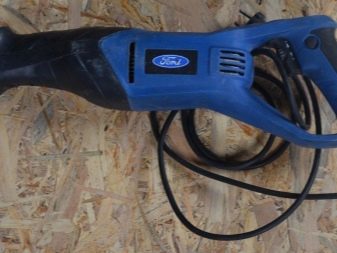

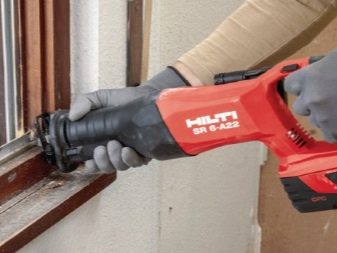

Types and characteristics
The versatility of the reciprocating electric saber saw greatly simplifies the potential classification, however, one should not think that such a tool differs in different models only in insignificant details. In fact, there are several main criteria for classification, each of which can be of decisive importance when choosing a tool.
To begin with, we note that the electric hobbyist, like most other electric tools, can work either directly from the mains or from a battery. As is often the case, network models turn out to be much more powerful, for them there are no unsolvable problems at all, moreover, they weigh relatively little and can work almost indefinitely. At the same time, the main problem of such units remains that their use is appropriate only in conditions of “civilization” - where there are no working outlets nearby, there will be no sense from them.
But battery models, on the contrary, are not very small, because a battery adds weight and dimensions to them, and in terms of power they can be attributed to the conditional category "mini", but you can use them without restrictions in terms of location - even in the garden, at least in a high-rise building under construction from scratch.
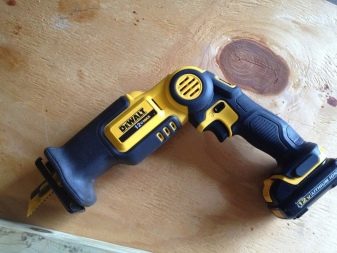

In addition, for the convenience of choosing a specific model by novice consumers, there is also a conditional classification into household and professional saws. Moreover, most often the assignment to one or another class really indicates where to apply the unit.
- Household models differ in the most modest characteristics. Their power is usually limited to a limit of 600 W, and even the network options do not imply long-term continuous operation - after only a few minutes they must be turned off so as not to burn the engine. Each such manual model is distinguished by its modest size and the same weight, the number of operating modes is reduced, and the materials for the manufacture of the case and the main units are mainly budgetary. All this has a positive effect on the cost of the device, however, for solving small household problems, it still remains quite effective.


- Professional reciprocating saws, accordingly, are called upon to solve much more serious problems. The power has been significantly increased - in this case, it cannot be lower than 700 W, and the entire system as a whole has been worked out in such a way as to allow significantly longer work without interruptions. The materials used in the production process are of much higher quality, which has a positive effect on the durability of the tool, besides, manufacturers do not spare various additional functions that allow solving diverse problems with one device. Because of this, the weight and dimensions of the unit increase, and the price rises, however, for the everyday solution of various construction tasks, one has to put up with this situation.

- "Heavyweights" - a very conventional group of reciprocating saws, distinguished among professional pneumatic models for especially valuable characteristics. This cannot include a model with a power less than 1200 W, such units are usually specially designed for the constant cutting of materials with a high level of resistance, such as stone and metal.
Some devices are even equipped with three blades at once, one of which does not move at all and only directs the working pair, and although this significantly increases the kerf width, the tool will please with increased productivity and conspicuous accuracy of work.

In recent years, reciprocating saws have been positioned precisely as a universal solution for cutting materials of any type, however, not so long ago, it was impossible to use replaceable blades for different materials, because the same saws for metal and wood were different tools. It should not be ruled out that even today cheap models can be sharpened for processing only one type of material, which should be clarified before making a purchase.Also, please note that for the processing of particularly strong structures, a specific heavyweight model may be required.
Better to clarify if it is suitable for the potentially hardest material you are processing. According to this criterion, for example, reciprocating saws for concrete are distinguished.
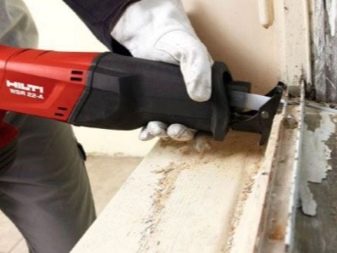

Rating of the best models
It is always problematic to compose an adequate review of an electric tool - leading brands, fighting for a buyer, update their model lines every year, releasing all new interesting proposals, not to mention the fact that a different device is needed to solve different problems. With all this in mind, we will not make a comparison or allocate places - just consider a few current models of reciprocating saws that are in demand at the moment. Do not take the list below as an indispensable purchase recommendation - perhaps the ideal solution for you is not presented in it.
- Bosch GSA 10.8 V-LI 0 Is a good example of a cordless lithium-ion battery saw that will come in handy in a large construction site. Weighing only 1.2 kg, the unit is very powerful - according to builders who tested the device in practice, it confidently cuts materials of any strength. The engine is well developed, thanks to which the blade moves smoothly, for the convenience of work, the illumination of the working area is also built into the body. At the same time, if such a model is criticized, then for a relatively small battery capacity - it will definitely not be enough for a whole day of work. Often dissatisfaction is caused by the cost, which often exceeds 8 thousand rubles.

- AEG US 400 XE Is an example of a household reciprocating saw that should not be the weak link. This network unit, with its low power, costs a lot, and all because it was made conscientiously - for those owners who are ready to regularly engage in small and medium repairs around the house. The reliable device weighs almost 2 kg and is equipped with a 4-meter cord, which allows you to stretch the cable to any part of the apartment from the nearest outlet. The mechanism allows the operator to freely adjust the depth of cut, the replacement of the saw blade in the chuck with a universal mount is carried out with bare hands - no additional tools are required for this. The criticism of the model is based, again, on the rather high cost, as well as on the absence of useful pendulum motion and soft start at such a price tag.

- Makita JR3070CT - a super-powerful network unit, whose engine produces 1510 W, which is not surprising at a price of 13 thousand rubles. The disadvantages of such a tool are quite difficult to find - it is equipped with full functionality, including pendulum stroke, smooth start, universal saw blade attachment, stabilization of the number of revolutions with increasing load and manual adjustment of the cutting depth. Such a device is capable of biting into wood of any species to a depth of 22.5 cm, which in fact allows it to cut down most garden trees with it. The weight of 4.6 kilograms somewhat complicates the task of constantly working with such a unit, however, it would be very difficult to find a tool of less weight similar in power and other characteristics.
The only not too justified drawback is the cable length, which is only 2.5 meters, but this problem can be solved by using extension cords.

How to choose?
Experts in the choice of construction tools advise when buying a reciprocating saw to carefully read the technical specifications, not really listening to the rantings of store consultants that this or that model belongs to one or another class of products. Seeing that you are not very well versed in the issue, the consultant can theoretically call any unit semi-professional, especially since in fact such a definition does not exist at all.Again, only you know for what specific purposes the unit is purchased, and after all, not every household model is able to solve all household problems, just as a professional one does not always solve any construction problem.


Although the main selection criterion is almost always called the power of the electric motor, it is still worth starting from the time of continuous operation - in the case of a reciprocating saw, it should be indicated in the technical passport. As we mentioned above, an inexpensive household model can heat up in an extremely short time, and in some cases this can create problems even when solving household tasks. This factor is even more important if you are interested in a saw for everyday work - Before purchasing it, you must be sure that the downtime will not exceed the uptime.

In terms of power, the choice is quite difficult. If you need a saw for your home, then a typical household model can be limited to only 600 W, and modest models have 400 W of power at all, however, here you need to understand that buying such a modest unit is a risk of wasting money. It is possible that even a low-power engine will master any structures within an apartment, but performance also depends on the power, therefore it will take a lot of time to cut the same pipe - especially considering that a cheap device heats up too quickly. According to this logic, one could buy a powerful saw even for household needs, but with an increase in power, the price rises rapidly, and then the question arises about the expediency of such costs.
Considering all of the above, experts usually recommend choosing a kind of middle in the form of models with a power of 900-1200 W, but, again, it all depends on how you yourself see the potential front of work for the purchase you are making.


The range of motion of the blade indicates how wide the range of movement of the saw in a reciprocating motion is. Too little value indicates that the saw is "marking time" in place, too large - that when cutting thin sheet materials, unreasonably much energy will be spent on the return movement. For this reason, experts advise choosing a model with an amplitude of 19 to 32 mm - such characteristics are suitable for most sheet and panel materials.

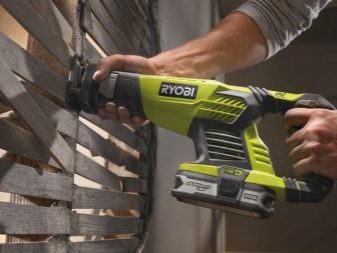
With the frequency of movement of the equipment, everything is all the more clear - the more intensively the blade moves, the higher the cutting speed. For a reciprocating saw, the normal average value is 2.5-3 thousand strokes per minute. Finally, such an indicator as the depth of cut shows how deeply the blade can go into the thickness of the material without harming itself and the process of performing the work. For some models, this indicator can reach 25 cm, but it should be chosen with an eye to the thickness of the materials that you usually process - so, just a few centimeters of depth will be enough for cutting garden trees.




Not all characteristics of reciprocating saws are indicated by numerical values. For example, the presence of a speed regulator allows you to select for each material its own number of reciprocating strokes per minute, which allows you to more intensively saw strong and protect the edges of fragile material. In models with a stepless regulator, the trigger works like a gas pedal - the more the operator presses on it, the more the number of reciprocating strokes increases.
The step regulator allows you to more accurately set the speed; it is implemented on the principle of a separate slider or wheel, which, when set to a certain position, provide a stable number of strokes every minute.



The same pendulum motion, which we have already mentioned above, is considered almost an obligatory attribute of a good reciprocating saw, however, it is not present in all models.Although its presence makes it possible to reduce the heating of the working blade, and, accordingly, allows it to remain intact for longer, during figured cutting, the pendulum stroke is almost always turned off, otherwise damage to the workpiece will become almost inevitable. In expensive models, the pendulum stroke is not only present - it can be adjusted by controlling the span of the canvas. The same support shoe is featured in all or nearly all reciprocating saw models, however, it is not equally well thought out everywhere.
So, the rotary version of this part allows not only to use a multifunctional saber more productively, but also makes it possible to perform a neat cut at any angle of inclination.
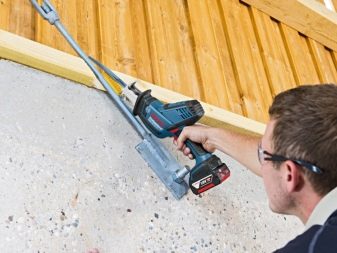

As in the case of other power tools that involve the installation of interchangeable tooling in the chuck, manufacturers in recent years increasingly refuse to use special keys when replacing the blade. Today, most models are equipped with chucks that are equipped with lever clamps or retaining rings, so blade replacement is quite easy and with bare hands. At the same time, many leading companies today offer a special design of the chuck, which allows the blade to be installed with the teeth not only downwards, but also upwards, and this versatility is usually very positively evaluated by professionals.


It just so happened that almost all power tools that pose a certain risk of injury are protected by hazardous components in the form of a safety clutch. When choosing a reciprocating saw, you should not rely on the fact that this unit is there by default - unfortunately, some budget models are deprived of it. The built-in motor overload protection is also a very valuable bonus. A reciprocating saw is a rather delicate tool, in a household version it heats up very quickly, therefore it is not so difficult to burn out its engine.






If you are not entirely sure that you can accurately capture the moment of the necessary shutdown of the device, it is better to buy a model with automatic shutdown of the motor.
There are several other functions that cannot be noted:
- with the help of a soft start, the motor does not start abruptly, gradually gaining high speed, which protects the mechanism from rapid wear;
- the built-in brake allows the blade to stop abruptly after completion of work, if you need to quickly replace it or there is a possibility of injury to someone;
- locking the trigger allows you not to keep your hand on the trigger all the time, fixing one or another of its position;
- double insulation allows you to use the device even outdoors in wet weather;
- professional models are often equipped with elastic pads on the handle and gearbox, which significantly reduces vibration, and in expensive models - also noise.

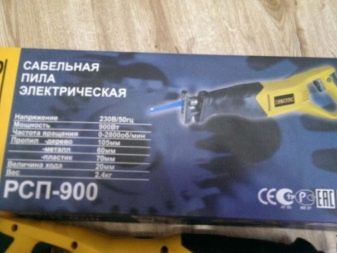
Subtleties of application
Compliance with the instructions is very important in the case of any power tool, but in the case of a reciprocating saw it is especially important, because budget models of such a unit can burn after a few minutes of use. For this reason, for a start, it is worthwhile to carefully study the operating conditions of the device and in no case ignore what is indicated in the recommendations. If the mechanism is not yet equipped with an automatic overload protection function, then you should react as quickly as possible to the heating of the engine and do not forget to glance at your watch so as not to exceed the permissible time of use.

For effective use of the reciprocating saw, and most importantly, in order to avoid its premature deterioration, it is necessary to choose the right replacement blades for each material and never ignore their timely replacement, even if the materials being cut alternate at a kaleidoscopic speed. Choosing the right reciprocating saw blade in each case is a whole topic for a separate article, but if you are going to use the purchase for a long time and productively, do not be lazy to delve into this topic.

In the process of work, you should always remember that A properly equipped reciprocating saw is able to overcome almost any obstacle, therefore, careless handling can lead to serious injury. Most manufacturers in the instructions describe the process of performing the work as accurately as possible, indicating how to properly hold the tool in your hands, what to remember, in what sequence to start and finish the task.
All these recommendations have been tested over decades of using such a tool, so you should not think that some of the provisions can be ignored.

A separate point is the independent repair of equipment. Most of the major manufacturers directly indicate that unauthorized access under the cover is prohibited - these can only be dealt with by employees of authorized service centers. A violator of this rule runs the risk of being left without warranty service for his copy, since most brands refuse to be held responsible for the functional conformity of saws in which outside interference has been made.
However, even if you are completely confident in your own abilities and are ready to try to fix a stale tool yourself, you should always remember at least that before opening the lid, the device must be turned off and disconnected from the outlet or removable battery.

Owner reviews
In our country, saber-type electric saws are still relatively rare, however, their distribution is increasing every year, and with it the number of comments from owners on specialized forums is growing. It should be noted that opinions sometimes differ in polarity, however, there is a general pattern - the branded models of famous companies are criticized quite rarely, mainly praising, while the general criticism mainly concerns inexpensive products of unknown Chinese manufacturers.

Among foreign companies, the German Bosch and the Japanese Makita have won good fame, Interskol is distinguished from the Russian ones, although it is usually noted that foreign competitors win the competition. For branded products, usually all indicators are quite good - here both the reliability of the unit, and the duration of operation without interruption, and durability, and the presence of various additional functions. Even if such a tool breaks down, it is usually not difficult to find a service center, the parts are also presented in any large city, so there should be no problems with repair and maintenance.
True, saws from famous brands are much more expensive than "nameless" ones, however, consumers usually understand that you have to pay for quality.
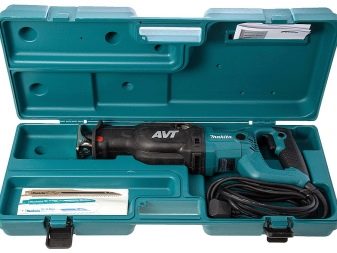
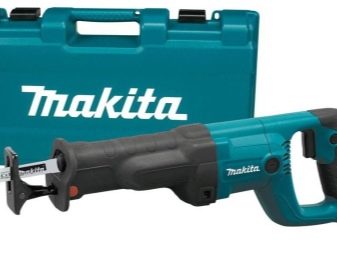
Critical reviews usually refer to Chinese products, of which there are even too many on the world market lately. It is not always easy to define it - there may not be a single hieroglyph on the box, and the company itself may position itself as European or American, however, this usually does not matter if the production is located in China. At a very low cost, such reciprocating saws often attract inexperienced consumers, but then they are forced to write disappointed comments on the forums, complaining about the low functionality, fragility of the unit and the impossibility of its adequate repair in Russian conditions.
For information on what reciprocating saws are, see the next video.













The comment was sent successfully.